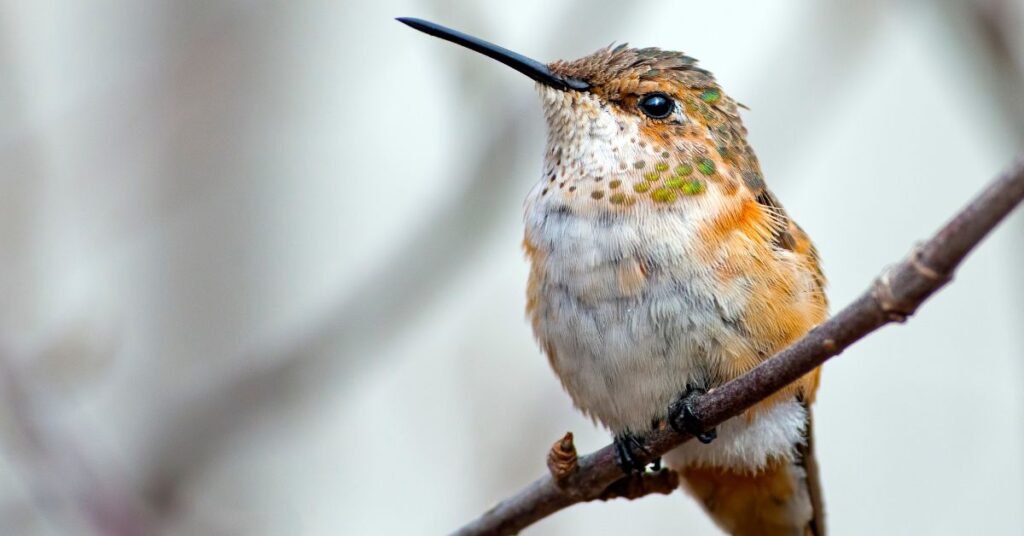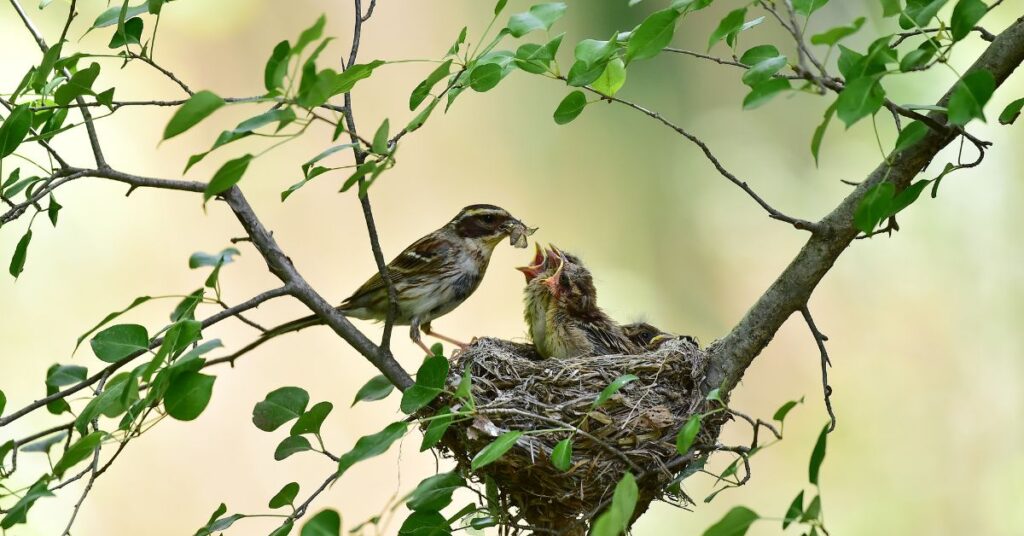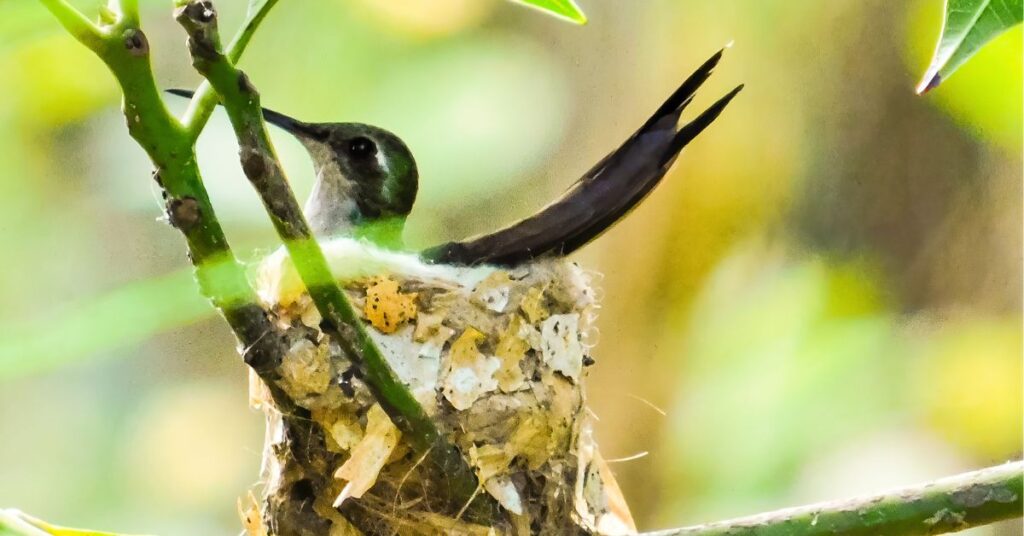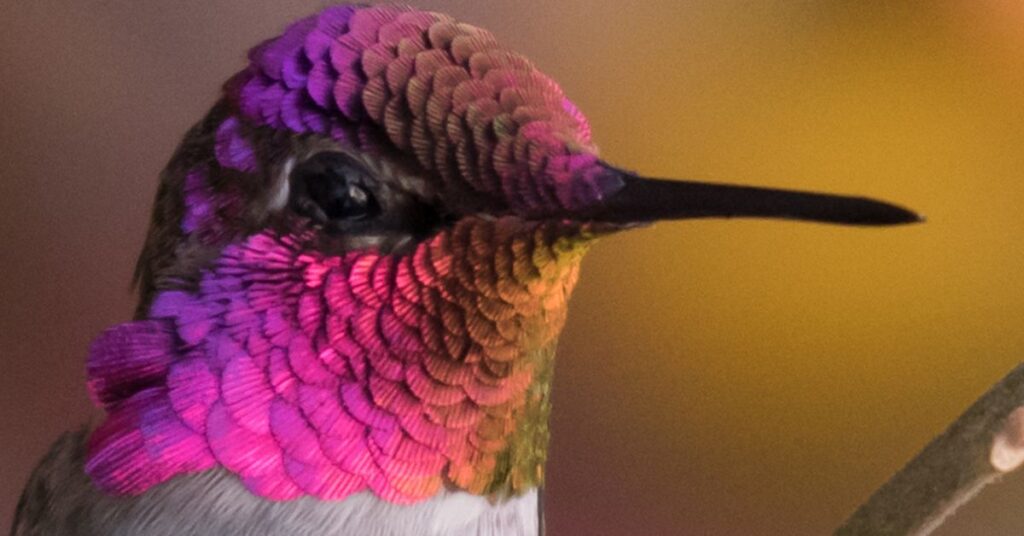As a bird lover, have you ever asked how long Hummingbirds live? The average lifespan of a hummingbird is about 3-5 years. However, some have been known to live as long as 12 years in captivity.
Hummingbirds, with their vibrant colors and rapid wing beats, have captured the fascination of bird enthusiasts and nature lovers alike. These tiny creatures bring joy to our gardens and fill our lives with wonder. One question that often arises is, “How long do hummingbirds live?”
In this article, I will look into the intriguing lifespan of these remarkable birds, delve into their aging process, discuss threats and predators they face, and provide valuable insights on caring for them. Let’s embark on this fascinating journey together.
Click here to learn how fast Hummingbirds fly.
Let’s dive in!
How Long Do Hummingbirds Live?

A hummingbird lives for 3 to 5 years on average. Some hummingbirds, however, have been reported to survive for up to ten years. A hummingbird’s lifespan varies according to species, environment, and individual birds.
A hummingbird’s lifespan can be affected by a variety of variables, including:
- Species: Some species of hummingbirds are more long-lived than others. For example, the Anna’s hummingbird has an average lifespan of 5 years, while the bee hummingbird has an average lifespan of just 2 years.
- Environment: Hummingbirds that reside in warmer climates tend to live longer than those who live in colder climes. This is because warmer temperatures help the hummingbird live longer.
- Individual bird: Some hummingbirds are simply healthier than others and hence live longer. This could be attributed to a variety of variables, including genetics and food.
Hummingbirds are fascinating creatures; their lifetime is just one of the numerous characteristics that distinguish them. Despite their small size, are tenacious and adaptable birds that can survive in a variety of situations.
Hummingbirds Fact and Statistics
| Smallest bird in the world: The bee hummingbird measures just 2 inches long and weighs less than 2 grams. |
| Fastest flyers in the world: Hummingbirds can fly up to 60 miles per hour in a straight line, and they can also hover in mid-air. |
| Fastest hummingbird: The Anna’s hummingbird can reach speeds of up to 98 kilometers per hour (61 miles per hour) in a dive. |
| Wing structure: Hummingbirds have a unique wing structure that allows them to fly so fast. Their wings are shaped like a boomerang, and they can beat their wings up to 80 times per second. |
| Metabolism: Hummingbirds have a very high metabolism, which means that they need to eat a lot of food to stay alive. They typically eat nectar from flowers, but they will also eat insects. |
| Migratory birds: Some species of hummingbirds are migratory birds, and they travel long distances between their breeding and wintering grounds. The ruby-throated hummingbird, for example, migrates from North America to Central America and Mexico. |
| Pollinators: Hummingbirds are important pollinators, and they help to spread the seeds of many plants. |
| Lifespan: The average lifespan of a hummingbird is 3 to 5 years. However, some hummingbirds have been known to live for up to 10 years. |
| Conservation status: Some species of hummingbirds are threatened or endangered. The main threats to hummingbirds include habitat loss, climate change, and pesticides. |
Species-Specific Variations in Lifespan
Different species of hummingbirds exhibit notable variations in lifespan. On one end of the spectrum, smaller species like the Bee Hummingbird live for about three to five years. Moving up the scale, larger hummingbirds such as the Ruby-throated Hummingbird can live up to six years.
Interestingly, the legendary Albatrosses hold the record for the longest-living bird, with some individuals reaching an astonishing age of 50 years.
Hummingbird Aging Process
The Challenges of Studying Hummingbird Aging
Studying the aging process in hummingbirds poses numerous challenges. These speedy aviators are elusive and challenging to capture, making it difficult to obtain accurate data on their aging patterns. However, researchers have made notable observations to shed light on this intriguing subject.
Notable Physiological Changes with Age
As hummingbirds age, they undergo certain physiological changes. Their feathers may lose some of their vibrant colors, and their metabolic rate, once incredibly high, tends to decrease slightly. Additionally, their muscles may experience gradual wear and tear, resulting in reduced flight capabilities. Nonetheless, even in their later years, hummingbirds display remarkable agility and grace.
Behavioral Patterns as Hummingbirds Mature
Behavioral patterns also change as hummingbirds mature. Younger hummingbirds are often more adventurous, exploring their surroundings and engaging in playful displays. With age, they may become more focused on territorial behaviors and mating rituals. Their vocalizations also evolve, becoming more intricate and distinctive as they gain experience in their environment.
Caring for Young Hummingbirds

Nesting Habits of Hummingbirds
Hummingbirds build delicate and intricate nests, often using soft materials such as plant fibers and spider silk. These nests are typically found on tree branches, nestled away from predators. Female hummingbirds take great care in constructing and maintaining their nests, ensuring a safe and comfortable environment for their young.
Principles of Parental Care
Once the eggs hatch, the female hummingbird takes on the responsibility of feeding and caring for her offspring. She diligently collects nectar and insects to provide a nutrient-rich diet for her growing chicks. The male hummingbird may also participate in feeding duties, assisting the female in raising their young.
Survival Rates of Offspring
Survival rates for young hummingbirds can vary significantly depending on various factors such as climate, availability of food, and the presence of predators. The mortality rate can be high, with only a portion of the offspring reaching adulthood. However, each successful fledgling represents the continuation of these magnificent creatures and ensures the perpetuation of their species.
Threats and Predators
Natural Predators of Hummingbirds
Hummingbirds face numerous natural predators in their habitats. Predatory birds such as hawks and falcons pose a constant threat, relying on their speed and agility to catch these tiny birds in mid-air. Snakes, lizards, and even larger insects may also prey on hummingbirds opportunistically.
Human-Induced Risks and Habitat Destruction
Human activities contribute to the risks faced by hummingbirds. Loss of habitat from deforestation, urbanization, and agriculture encroachment disrupts their natural environments and food sources. Collisions with windows and exposure to toxins from pesticides and herbicidesalso endanger the lives of these delicate birds.
The Impact of Climate Change on Hummingbirds’ Lifespan
Climate change poses a real threat to the lifespan of hummingbirds. Shifts in temperature as well as precipitation patterns can disrupt flower blooming schedules, impacting the availability of nectar, the primary food source for hummingbirds. These changes can disrupt their migratory routes and lead to food scarcity, affecting their survival and overall lifespan.
How to Tell if a Hummingbird is Sick or Dying

Hummingbirds, like any other living creature, can become sick or face mortality. It’s essential to be able to recognize signs of illness or distress in these tiny birds. Some common indicators include unusual lethargy, difficulty flying, unkempt feathers, visible injuries, or changes in feeding patterns. If you observe any such signs, it may be necessary to intervene and provide appropriate care.
How to Care for a Sick or Dying Hummingbird
Caring for a sick or dying hummingbird requires utmost care and sensitivity. If you find a distressed hummingbird, the first step is to create a safe and enabling environment. Provide a small amount of sugar water (one part white granulated sugar to four parts water) in a clean and shallow container. Place the container near the bird, ensuring it has easy access to the sweet nectar. Contacting a local wildlife rehabilitation center is also highly recommended for professional assistance.
How to Prevent Hummingbird Mortality
Preventing hummingbird mortality requires proactive measures to safeguard their well-being. Planting a diverse array of native flowers in your garden will provide them with ample sources of nectar.
It is essential to refrain from using pesticides or herbicides near hummingbird-friendly areas to prevent unintentional harm. Regularly clean feeders and replace nectar every few days to prevent the growth of potentially harmful bacteria.
What is the Longest-Lived Hummingbird?
While hummingbirds generally have shorter lifespans compared to other bird species, some instances of remarkable longevity have been observed. The Broad-tailed Hummingbird, for example, has been known to live up to 12 years. Individual lifespans may vary due to factors such as genetics, environment, and available food sources.
How Can You Tell the Age of a Hummingbird?
Determining the age of a hummingbird can be challenging, as they do not exhibit readily identifiable age-specific characteristics. The most accurate method is banding, which involves placing a small metal or plastic band around their leg for identification purposes. Banding allows researchers to track individual birds, monitor population demographics, and gain insights into their age distribution.
Do Hummingbirds Have Memories?

Hummingbirds possess remarkable memory capabilities. They display intricate spatial memory to navigate their surroundings, remembering the locations of abundant flowers and feeders. They also remember routes during migration, guiding their incredible journeys across thousands of miles. These memories are instrumental in their survival and adaptation to changing environments.
Which Birds Have the Shortest Lifespan?
Hummingbirds, with their average lifespans ranging from three to six years, are generally considered to have relatively short lives in the avian world. However, certain small songbirds, such as warblers and wrens, have even shorter lifespans, ranging from one to three years. These birds face various challenges such as predation and environmental factors, which contribute to their shorter lifespans.
Is There a White Hummingbird?
Yes, white hummingbirds do exist, albeit being rare. These unique individuals exhibit a genetic condition known as leucism, resulting in a lack of pigment in their feathers. While their feathers lack color, their eyes and beaks still retain the characteristic hues commonly associated with hummingbirds. Spotting a white hummingbird is an extraordinary sight and a testament to the diversity that nature bestows upon us.
What is a Hummingbird’s Special Ability?

One of the most exceptional abilities possessed by hummingbirds is their remarkable agility and maneuverability in flight. Their wings beat at an incredible rate of around 50 times per second, allowing them to hover in mid-air, fly backward, and even upside down. This unmatched aerial prowess enables them to access nectar hidden deep within flowers and outperform most other birds in terms of flight capabilities.
Are Hummingbirds Considered Intelligent?
Hummingbirds display astonishing intelligence, tightly intertwined with their impressive memory skills. They can remember thousands of flower locations and the optimal routes during migration, adapting to changing conditions. Additionally, their ability to learn quickly and solve complex problems, such as navigating intricate artificial feeders, highlights their high cognitive abilities.
Why Don’t You See Baby Hummingbirds?
Baby hummingbirds, known as hatchlings or chicks, spend the initial weeks of their lives nestled in their nests. These delicate creatures often remain hidden from sight to minimize the risk of predation.
Parental care is crucial during this vulnerable stage, with the adult hummingbirds diligently providing nourishment and protection. Only when the chicks have grown and developed enough to leave the nest do they venture out into the world, oftentimes bypassing the noticeable “baby” phase.
Conclusion
Hummingbirds, with their astonishing beauty and captivating behaviors, continue to captivate our hearts. Despite their relatively short lifespans, these remarkable birds make the most of their time on Earth, bringing joy to our lives through their vibrant presence.
By understanding and appreciating the factors that influence their longevity, we can ensure their well-being and contribute to their survival. Let us treasure and protect these tiny aviators who grace our gardens and remind us of the wonders of nature.
If this article is helpful consider subscribing to my weekly newsletters for updates.
FAQs
How often should I replace the nectar in my hummingbird feeder?
It is recommended to replace the nectar every 3 to 5 days, or sooner if it appears cloudy or discolored.
What is the best recipe for homemade hummingbird nectar?
The best mixture is one part white granulated sugar to four parts water, boiled briefly, and cooled before filling the feeder. Avoid using honey, brown sugar, or artificial sweeteners.
How can I attract hummingbirds to my garden?
Plant a variety of native flowers with bright blooms and cultivate hummingbird-friendly plants such as trumpet vine, bee balm, and salvia. Provide clean and well-maintained feeders with fresh nectar.
Should I leave my hummingbird feeders up all year round?
In regions where hummingbirds migrate, it is ideal to keep the feeders up a couple of weeks after the last sighting of hummingbirds before taking them down for the season. In warmer regions where hummingbirds stay year-round, feeders can be kept up throughout the year.
Can I use red dye in the hummingbird nectar?
It is advisable to avoid using red dye or food coloring in hummingbird nectar, as it may be harmful to their health. The vibrant red color of your feeder is generally sufficient to attract these beautiful birds.
What type of feeder is best for attracting hummingbirds?
The ideal choice for attracting hummingbirds is a tube feeder with vivid red or orange hues and several feeding openings. The colors are meant to look like the flowers they like, and the many ports allow several birds to feed at the same time. Consider feeders with built-in perches for their convenience. Using a sugar-water mix that resembles nectar will increase the likelihood of their visit. Cleaning and maintaining the feeder on a regular basis is critical to keeping the birds healthy and returning.

